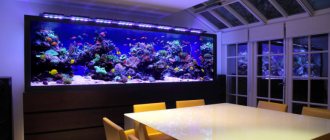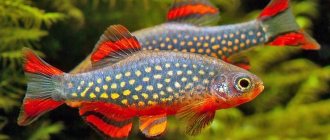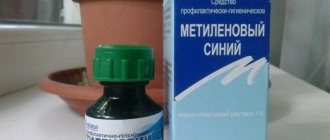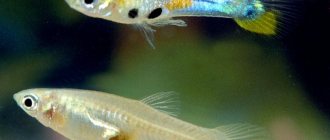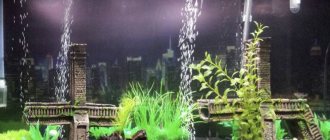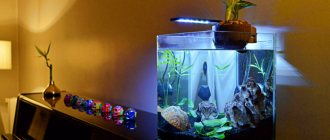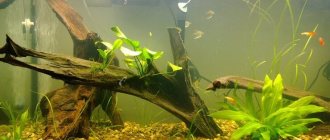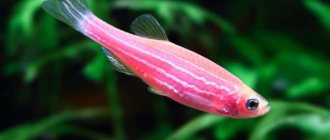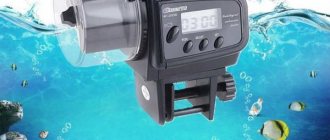What is sidex and what is it used for in an aquarium?
Once upon a time, an American company developed and released a product for the destruction of protozoan algae in artificial reservoirs called “Cidex Activated Glutaraldehyde”. Currently, all drugs used against lower algae are called sidex.
For the careful and gradual removal of harmful plant organisms from small aquariums, experts recommend the use of the German product “Tetra Algetten”.
The tableted drug, slowly dissolving in water, kills filamentous algae, blue-green algae and black beard, ridding the aquarium of green plaque on the walls and bearded growths that parasitize the leaves of higher plants and fish.
Follow the dosage specified by the manufacturer so as not to destroy the entire flora and fauna of the aquarium.
Cidex, when dosed correctly, will not cause any damage to fish, snails and higher algae, but it disinfects the water, destroying harmful flora.
Spores of the simplest types of algae can get into the aquarium with newly purchased plants, fish or equipment. They then spread very quickly in the water, cutting off access to air and light. If measures are not taken, the fish will begin to get sick and die.
The drug fights threadbare and black beard
Dosages and instructions for using Sidex in an aquarium.
Firstly, you should be careful when using Sidex at home. Do not forget that this is a disinfectant and should be treated at least the same as bleach and other household chemicals. I advise you to ensure adequate ventilation in the room while using this product. Sidex dosages may vary depending on the goals being pursued. Since, in addition to being effective against algae, it can be used in smaller dosages as a source of carbon for plants. Two schemes for applying Sidex are described below.
Glutaraldehyde as an anti-algae agent.
In order to be fair to all drugs containing glutaraldehyde and not to focus on the completely non-aquarium product Sidex, in the future I will refer to the active substance - glutaraldehyde, or pentandial. So, among all the algae that are found in the aquarium, glutaraldehyde (pentandial) is the most effective against blackbeard. Reports of the effectiveness of glutaraldehyde on filamentous bacteria range from extremely positive to extremely negative. This is due to the fact that aquarists call one type of algae blackbeard. Many types of green filamentous algae are called filamentous. Glutaraldehyde is effective against some types of filamentous green algae, but not against others. Very often, one type of green filamentous algae can be distinguished from others only under a microscope - visually they are very similar.
Many recommend removing organic residues as much as possible and siphoning the soil. I believe that siphoning the soil in a planted aquarium before using glutaraldehyde can be harmful, since this is additional stress, since we are already planning to subject the aquarium ecosystem to considerable stress. To prepare the aquarium, it would be most appropriate to remove algae, which can easily be removed by hand and the water changed. And it makes sense to carry out soil siphoning only in aquariums with a large number of cichlids, which is already done in them regularly.
Depending on the problem, different dosages of glutaraldehyde are used. A small dosage of 2.5 mg/l glutaraldehyde helps combat the soft green coating on the walls of the aquarium. But not in cases where it already exists, but only as a constant prevention of the appearance of plaque. That is, pentandial can be added at this dosage almost on an ongoing basis without harming the fish. The standard dosage - 5 mg/l glutaraldehyde works well against black beard, provided that it is applied for 5-7 days. On the second day, the black beard turns red, then becomes whitish. On the seventh day it completely disappears. This dosage is not recommended to be used on an ongoing basis, as a deterioration in the condition of the fish may be observed. An increased dosage of glutaraldehyde - 7.5 mg/l is used only in extreme cases, when there is an abundance of algae in the aquarium that cannot be picked out by hand. At this dosage, in addition to blackbeard, some types of green filamentous algae, as well as blue-green algae, die. High probability of loss of fish and shrimp, especially sensitive species.
Glutaraldehyde as a growth accelerator for aquarium plants.
Depending on the density of planting in the aquarium, the dosage of glutaraldehyde to accelerate plant growth is from 0.75 to 1.5 mg/l per day. At this dosage, glutaraldehyde will not be effective against existing algae in the aquarium, but it will not cause stress to its inhabitants. This will double the plant growth rate. I would recommend using this method only in cases where it is not possible to organize a supply of CO2 gas. Regular carbon dioxide is by far the best source of carbon for plants in an aquarium. There is debate among aquarists about whether glutaraldehyde is consumed by plants or whether it has an indirect effect on the growth rate of plants in the aquarium. There are different theories and guesses. Some believe that glutaraldehyde is consumed by plants. Some believe that plants receive additional carbon dioxide after the decomposition of glutaraldehyde in the aquarium. And some even believe that plants do not consume glutaraldehyde and its metabolites at all, but accelerate growth due to the release of ammonium due to the defeat of nitrifying bacteria by glutaraldehyde. There is even such an extravagant theory, which is that glutaraldehyde destroys the outer cells of plants and supposedly because of this, plants grow better. But there are currently no full-fledged studies with unambiguous experimental confirmation or refutation of this or that theory. However, it is an experimentally proven fact that pentandial accelerates the growth of plants in an aquarium. An experimentally confirmed fact is that pentandial, like many other organic aldehydes, alcohols, and acids, are ultimately converted into CO2 in a biologically active aerobic environment. An experimentally confirmed fact is that plants can consume carbon from different sources: carbon dioxide through leaves, soil organic compounds (humus) through roots, carbohydrates in the in vitro method. And it does not require confirmation that carbon is introduced into an aquarium with pentandial (the pentandial molecule consists of 60% carbon), which in a closed aquarium system will certainly be consumed. And at what stage of the decomposition of pentandial the plants will take its carbon is not of particular importance for the aquarist.
Release form and composition
The drug is available in containers of 1.5 and 10 liters.
Sidex is a two-component system of a liquid solution with an unpleasant odor and a powder activator. The working solution is mixed immediately before use.
The main beneficial component of Sidex is glutaraldehyde, the disinfecting properties of which have been successfully used in veterinary medicine and agriculture to destroy spores of protozoa, fungi and viruses.
A concentration of 2-3% will not harm fish and higher plants, so you can treat the water without transplanting them into another container.
The main substance of Cidex glues cell proteins in lower algae and destroys intercellular walls. The activity of glutaraldehyde increases in hard water with high acidity.
When the substance enters the aquarium environment, the water quickly becomes saturated with carbon dioxide, its acidity changes to the alkaline side, and the water becomes cloudy from the many dead lower algae.
In addition, there is also a high content of nitrates, nitrites, nitrogen compounds and phosphates. In water, glutaraldehyde breaks down into water and carbon dioxide, forming glutaric acid. But just a day after using Sidex, there are almost no traces of it in the aquarium.
Sidex is available as a concentrated substance, but can be sold as a solution
Composition, release form, packaging
The active ingredient of the drug is a solution of glutaraldehyde, the drug contains 2.5%.
Important! It takes at least a month for the algae to completely disappear when using it.
The drug is available in a canister. It also comes with an activator (in powder form), which is added to the solution for medical disinfection.
Important! In addition to the drug "Cidex" (in the original - "Cidex"), the same manufacturer has the product "Cidex OPA". Do not confuse them, since only “Cidex” contains glutaraldehyde, and the second drug contains absolutely the wrong active ingredient , which makes it less effective.
Indications for use
A green coating of simple algae on the walls of the aquarium does not allow light to penetrate inside. The water becomes green and thick from a large number of filamentous algae, not allowing the fish to breathe properly.
Experts recommend using chemical treatment only when all other methods have been tried and have not worked.
In this case, neither catfish, nor snails, nor cleaning glass with a scraper, nor filtration will help cope with the scourge. And then immediate intervention by Cidex is necessary.
Dosage and instructions for use of Cidex
The dose for treating aquarium water depends on the degree of infestation of harmful plant organisms.
- For preventive purposes, add five to seven milliliters per hundred liters of aquarium water daily.
- With an average degree of contamination, up to 12 ml is administered once a day during the daytime for a week. It is not necessary to place fish here.
- In case of severe contamination with lower algae, aquarium inhabitants are removed and the dose is increased to a possible maximum of 20 ml.
To reduce the amount of Cidex used, it is recommended:
- first manually clean all side surfaces of green deposits;
- Thoroughly scrub the filter by rinsing it under running water;
- replace at least half of all the water in the aquarium;
- turn off the lighting;
- stop adding carbon dioxide to the water;
- connect aeration;
- the entire aquarium with a dark cloth of a dense structure (without light, photosynthesis is impossible, and harmful algae will die faster; higher plants will calmly survive a three-day light starvation);
- add the amount of substance recommended by the instructions;
- after 24 hours, change half the water again and add a dose of Sidex again;
- on the fourth day of treatment, change up to 70% of the aquarium water, rinse the filter thoroughly again under running water, siphon the soil, freeing it from the remains of dead algae;
- open the aquarium to light, connect a carbon dioxide saturation device;
- introduce phosphate and nitrogenous substances lost as a result of exposure to sidex.
The dose for treating aquarium water depends on the degree of infection by harmful plant organisms.
Simultaneously with Sidex, it can be used to cleanse shrimp, which happily eat dead algae.
Dosages of Sidex (glutaraldehyde)
These dosages are average, but time-tested. You should always take into account that all aquariums are different from each other and plants react differently to different dosages of Sidex. Sidex is applied at different times of the day and at different water temperatures. There are also newly launched (young) and old aquariums.
Sidex as an additional source of carbon dioxide is added every day, in the amount of 3-7 ml per 100 liters of aquarium water. I emphasize that you should know how much water you have in its pure form, and not the rough volume of the jar. It is recommended to start any application of Sidex with small doses.
Sidex as a means to combat black algae such as “blackbeard” or “flip-flops” is applied from 10 to 30 ml per 100 liters of aquarium water per day. I personally add from 15 to 20 ml per 100 liters and watch the aquatic organisms. At a concentration of 20 ml/100 l and above, the death of some shrimp and snails is possible. After introducing a large dose of a substance, aquatic organisms may not have enough air to breathe, they will begin to accumulate near the surface or may die from lack of oxygen. Therefore, when treating an aquarium with this method, it is recommended to supply air using simple aeration.
It is recommended to protect aquariums that are very seriously affected by such algae from light, add glutaraldehyde at night and turn on aeration. Personally, I did not do this, as it can be dangerous for plants, fish, shrimp and snails. This method requires some skill and experience. And being in a room with such an aquarium is not very useful. When treating an aquarium with glutaraldehyde, a faint, peculiar odor of the substance is noticeable from the water.
Adverse reactions
Aquarists who have used Sidex talk about some unsafe use:
- During treatment, the death of living tubifex, which serves as food for aquarium fish, was observed.
- Fish that ate the dead tubifex also died.
- Some higher algae died off along with the protozoa.
Sidex is a moderately dangerous disinfectant.
It can be irritating to human skin with repeated exposure. Dangerous in case of contact with eyes, which should be immediately rinsed with running water. Vapors of the substance, when inhaled, have a depressant effect on the respiratory system.
Instructions for use
Sidex for aquariums is sold in cans. It comes with a powder that is used for disinfection. The product is a solution of glutaraldehyde . Shelf life: 2 years. After this time, it is dangerous to use the liquid. It is stored in tightly closed packaging at a temperature of no more than +25°C.
The manufacturer does not recommend using the powder to control lower plants. To achieve positive results, you need to know the dosage. For prevention, 5-7 ml is used for every 100 liters of water in the vessel. The procedure is repeated daily.
Sidex should be used daily
For minor contamination, increase the dosage to 12 ml. It is recommended to fill the liquid in the daytime once every seven days. This amount of substance will not harm the fish, so there is no need to remove them from the aquarium.
It is not recommended to work with the drug without protection. It is necessary to protect your hands and respiratory tract. To do this, wear gloves and a respirator. If the substance gets on the skin or in the eyes, then urgently need to rinse these areas with water, and in case of complications, consult a doctor. After the product is added to the water, it is necessary to tightly close the container and ventilate the room.
Experts note that such a product can be used not only to completely remove algae, but also to destroy the “beard” on the leaves of ornamental plants. Harmful plaque is removed in two weeks if you do the procedure daily.
